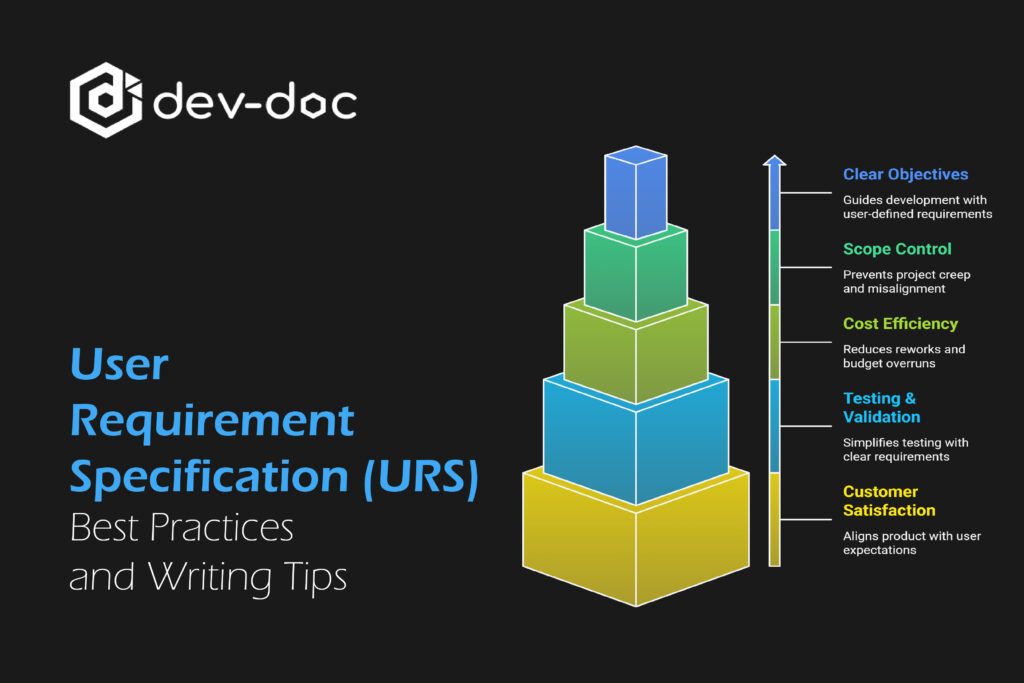A well-organized user requirement specification is one of the key elements of any successful software project, ensuring your team and stakeholders are on the same page. It clearly outlines user requirements, explains what the system should achieve, and how project success is measured.
Without a well-defined URS, software projects often face:
- Misaligned goals between stakeholders
- Scope creep from undocumented features
- Costly revisions and development delays
In this article, we’ll explore what a user requirement specification is, why it’s important, and some essential best practices to improve your URS writing process.
What is a User Requirement Specification (URS)?
A User Requirement Specification is an essential document for any software project that outlines the expectations, needs, and requirements of users for a software system. It acts as a blueprint for your team, ensuring the final product meets user needs and requirements.
Let’s take a quick overview of the importance of user requirement specification.
Benefits of a User Requirement Specification
User requirement specification works as a blueprint that guides the development process and prevents miscommunication, inefficiencies, and costly rework.
Provides Clear Project Objectives
The user requirement specification includes information about the functional and non-functional requirements of a system provided by the user. This approach clearly guides the development team, ensuring the team understands the project’s purpose and goals before the development process begins.
Prevents Scope Creep and Misalignment
If you already have experience working with a development team, you might be familiar with project creep. It’s a situation where the team needs to do additional work due to unexpected features and modifications being introduced. This URS becomes the best reliever in this case, keeping the development team focused and ensuring that the changes are evaluated and controlled properly.
Reduces Development Costs and Time
A clearly defined user requirement specification reduces the risk of reworks, delays, and budget overruns. It helps developers understand the user requirements at the beginning of the development process, which helps them avoid unnecessary iterations, making the development cycle more efficient and cost-effective.
Facilitates Efficient Testing & Validation
Well-organized and crystal-clear user requirement specification facilitates efficient testing and validation processes. When your testing team has clear project requirements, testers can verify that the system meets user needs perfectly. This also simplifies the overall acceptance testing, ensuring that the final outcome meets the user’s expectations and requirements.
Enhances Customer Satisfaction
The URS ensures the final product aligns with user expectations, leading to higher adoption rates and enhanced customer satisfaction. By focusing on what the user truly requires, your team can develop products that are relevant, effective, and user-friendly.
Best Practices for Writing an Effective User Requirement Specification (URS)
Here are a few best practices to improve your user requirement specification writing,
Define Crystal-Clear Objectives
When drafting the URS, provide a clear overview of what problem the system aims to solve and why the system is needed. Clearly outlining the goals and scope is crucial to provide a solid foundation for development. For example, you might write the following line to define the goal for an invoice processing system.
“The system will automate invoice processing to reduce manual workload by 50%.”
Use Simple and Unambiguous Language
Avoid technical words; instead, use clear, measurable, and specific language to eliminate confusion. For example, if you use sentences like “fast response time”, this might be hard to understand by a non-technical person.
Use key components perfectly.
A well-structured URS improves readability and usability. However, it’s essential to use the key components of a user requirement specification perfectly. In this article, we briefly describe the key components of a user requirement specification.
Prioritize Requirements
Not all the user requirements carry equal weight. Some of them are crucial, and some of them are optional. You can prioritize the requirements as follows:
- Must-have: Essential for functionality
- Should-have: Important but not critical
- Nice-to-have: Additional features if resources allow
This approach helps your team manage scope creep and align expectations.
Focus on User Needs, Not Technical Implementation
URS isn’t the place to define technical implementation. It should only describe what the system should do, not how it should be built. Must avoid mentioning technologies to implement the system in the URS as follows:
“The system must use OAuth 2.0 for password resets.”
Instead, you’ve to write this as,
“The system should allow users to reset passwords via email.”
Final Thoughts
A well-defined user requirement specification paves your way towards a successful project. It fills the communication bridge between stakeholders and the development team, reducing misunderstandings and ensuring the final product meets user needs.
Tools like Dev-doc, Document360, and Doxygen enhance the overall documentation process, making it easier to create, maintain, and update documentation that stays in sync with your project progress.
If you still have any questions or require any additional support. Feel free to contact us anytime.


In short, yes, but only if it goes with the texture of the day.